Wide defenders have a prevalent role in all of football, providing managers with new tactical options and methods of attack.
They are no longer restricted to pure defensive roles; rather, they are, in some cases, a focal point of a team’s attacking structure.
Women’s football, in particular, has seen some tactical innovations of their own in recent years, with coaches taking inspiration from their male counterparts.
Some of the ideas are quite fascinating, and they’ve formed part of the innovative thinking that has entered the women’s game.
The different uses that will be discussed in this analysis alone form part of the tactical complexity within these systems.
Over the last two seasons, we have seen different teams employ tactics using their wide defenders in defensive, offensive, and build-up transitions.
This tactical analysis will look to explore the different tactical setups and explore their effectiveness.
We will also analyse teams using these aforementioned systems and how they’ve implemented this into their structure.
Balanced full-back system
There are several tactical reasons behind this, namely, opposition teams’ preference to crowd and suffocate zone 14, forcing teams to the wide areas.
This simply reduces the chances for a team to score from the central areas.
One of the most common uses of full-backs has been the use of a balanced pair.
This essentially means that one defender will be more attacking whilst the other remains a bit more defensive.
This tactic is used when a team has a pair of full-backs that complement each other.
One may be an excellent attacking presence, while the other remains more defensively astute, giving the manager a way of balancing their team and allowing other players in midfield and attack to flourish.
Choosing the right type of full-backs in this situation becomes an important process.
Full-back pairings are entirely dependent on the types of players available in a squad.
Many teams have converted wingers or central defenders into full-backs to either provide defensive solidarity or attacking thrust.
Arsenal Women, Paris Saint-Germain Feminine, and the France women’s national football team are three notable examples of teams that possess a mixture of different types of full-backs but, more often than not, keep two solid options out wide.The use of these types of full-backs can be useful in games where teams are looking to keep the opposition wingers contained whilst retaining their attacking shape in regards to having two similar full-backs.
Arsenal, for example, utilise different pairings for different tactical reasons.
Viktoria Schnaderbeck, Lisa Evans, Leonie Maier, and Katie McCabe are their four full-backs.
In games where they want to dominate possession, they will look to pair aggressive full-backs who are equally offensive and defensive.
They used McCabe and Maier against Manchester United where they dominated 66% of possession but had to be wary of their counter-attacking potential.
The tactical thinking behind this was to use McCabe and Maier’s pace to track back and defend but also use their attacking prowess in combination with Danielle van de Donk and Beth Mead in attacking positions.
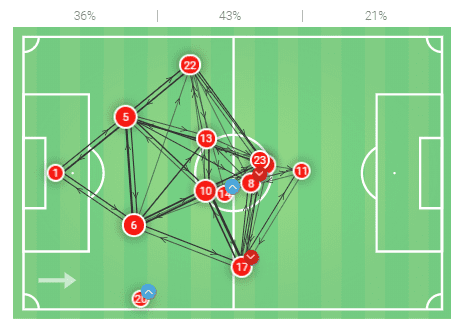
The main advantage of using balanced full-backs is the opportunity to create numerical superiority in midfield and attacking areas.
Taking a 4-2-3-1 formation as an example, when a full-back is paired with a forward who prefers to cut inside, it creates an almost 2-3-5 shape giving the attacking team an extra body in attack.
In doing so, the defending side are overwhelmed, especially in the half-spaces, and have to commit players from midfield to support the overload.
This, in turn, creates space for the full-back to make an overlapping run, leaving the centre-forward isolated with the centre-back and gives late runners from midfield a chance to attack the box.
The graphic below illustrates this scenario and the spaces that open for the attacking team.
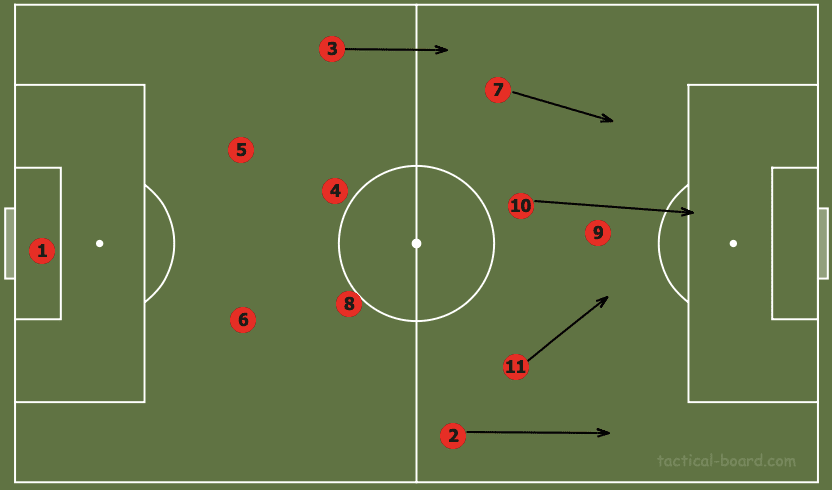
From a defensive perspective, the team provides enough cover to protect itself from a counterattack.
Just as Arsenal use McCabe and Maier, teams use their full-backs to drop back into a defensive position to stop the opposition from exploiting the centre-backs.
Often, teams compensate for a flying full-back by deploying a defensive midfielder who acts as an anchorman or half-back to cover the vacant space.
This kind of midfielder is one who remains disciplined in their defensive tasks and will retreat to become a third centre-back at times to maintain a back four.
Paris Saint-Germain Feminine utilise a combination of balanced full-backs and midfield protection to create attacking opportunities whilst remaining defensively compact.
They are a team that extensively uses their full-backs and adjusts its tactics depending on the type of opposition it faces.
PSG is especially prevalent and disciplined in its attempts to maintain its shape and compactness against top-quality, possession-dominant sides.
Taking their league match against Olympique Lyon as an example, PSG employed a 5-3-2/4-3-3 formation, with Grace Geyoro deployed as the deepest midfielder and a half-back.
The two full-backs were cautious and only attacked when the opportunity presented itself.
Both Perle Morroni and Hanna Glas took a reactive approach, which lent itself to a defence first, attack later mentality.
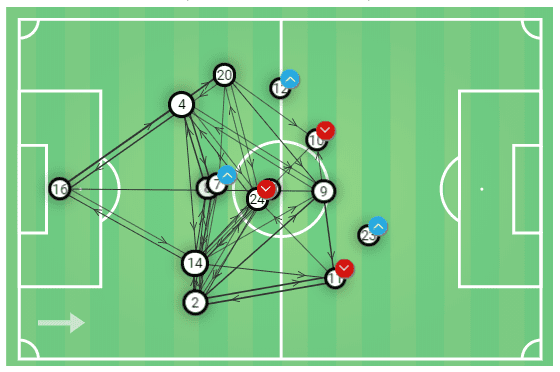
This pass map shows the two full-backs’ deeper positioning close to the two centre-backs.
Doubling up was done to contain the threat of Eugenie Le Sommer and Amel Majri.
Lyon concentrate their play through the wide space making the two wide forwards extremely dangerous to their attacking structure.
Both full-backs keep a close eye on the state of play and anticipate their next move.
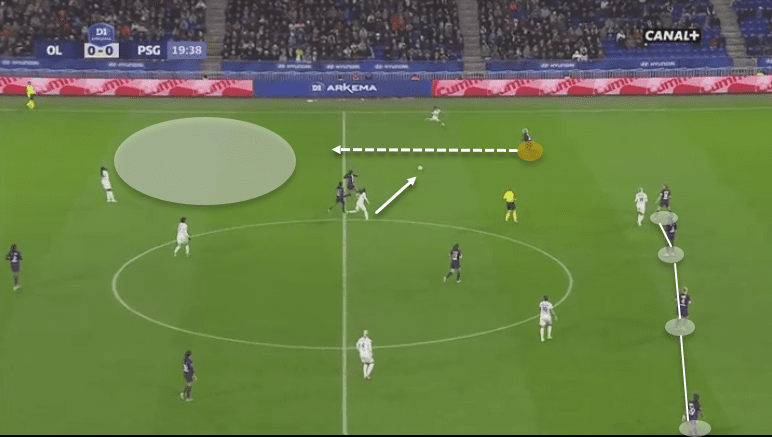
The most obvious tactical observation is PSG’s defensive shape.
We can see that four of the back five are in line creating a disciplined block with Glas stepping up to stop the attack.
Whilst on the opposite side Morroni has maintained her location and held a defensive position in the event Lyon win back possession.
Majri’s pass into Selma Bacha is intelligently anticipated and intercepted by Glas.
The Swedish right-back takes advantage of this situation and puts PSG on the counter-attack, exploiting the space in behind Bacha.
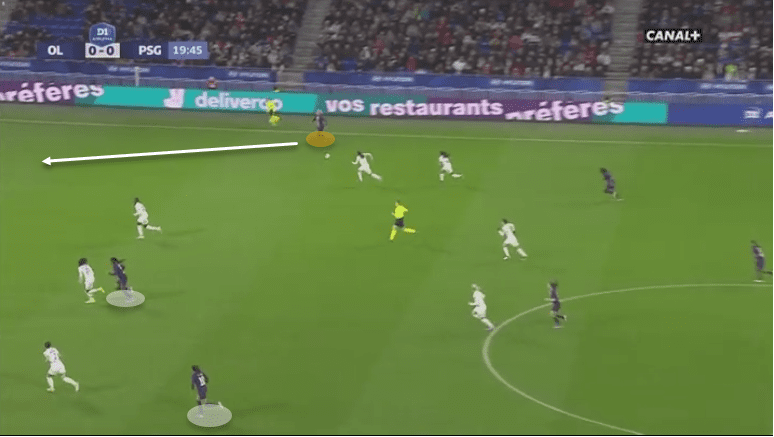
Glas interchanges play with her teammate and runs into the vacant space behind Lyon’s defensive line.
We can see Glas in an advanced position with no marker nearby.
While there are three covering defenders, Glas is in a great position to put in a quick cross for Marie-Antoinette Katoto and Kadidiatou Diani to latch on to.
Asymmetrical full-backs system
For more dominant, possession-based systems, teams often deploy a more aggressive shape and style to their tactics.
Part of picking this tactic is once again based on the playing squad and manager’s style.
If there is an outstanding candidate in the full-back areas then teams can play a more asymmetrical style to create a more lop-sided shape to leverage their attacking advantage on that flank.
Teams that have adopted a variation of this system have benefited from a few major advantages.
The dominant full-back often excels in carrying the ball forward and interchanges play with their midfield teammates.
Not only does this transfer possession effectively through the thirds but creates space in and around the final third.
This tends to switch the focus to the busier side, leaving the opposite flank with a bit more freedom for the winger to engage in 1v1 situations and late runs into the box.
We’ve seen this more so in three-man formations where the opposite wing-back is able to make late runs into the box.
Marcos Alonso’s goal against Tottenham Hotspur a few weeks ago is a perfect example of how high-flying wing-backs can effect the box offensively.
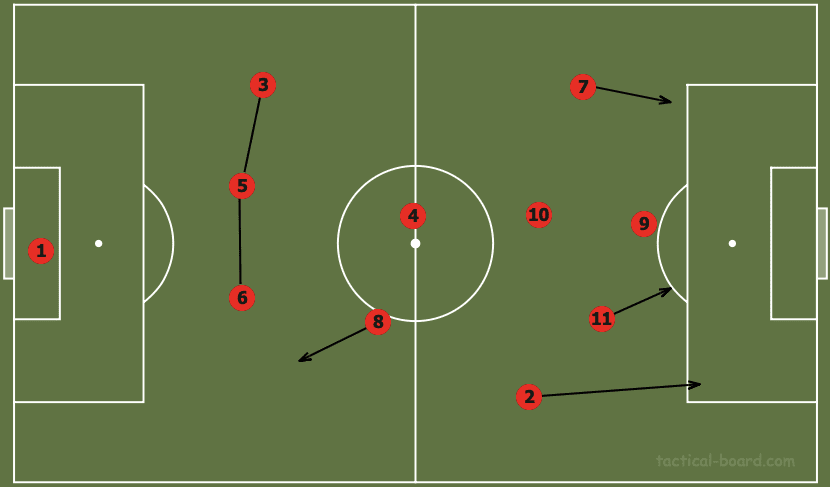
The shape of the team is quite distinct in both the offensive and defensive phases of play involving both full-backs.
Firstly, from an overall shape perspective, it becomes a lot more asymmetrical and lopsided.
While one full-back will spend most of their time higher up, the other sits in a narrower position closer to the central defenders to provide defensive cover.
In theory, the defensive full-back becomes an auxiliary central defender when teams counter-attack because of their deeper, slightly narrower positioning.
The above graphic illustrates the team’s shape and gives us an indication of the two full-back’s positioning.
You’ll usually find more defensive-minded players being used in this position, and in some cases, centre-backs are converted into full-backs.
The defending team is also subjected to cover in the central area, consisting of up to three players with the closest defensive midfielder providing extra support.
From an offensive perspective, the team shape becomes very one-sided.
The attacking team becomes much more potent down one side of the pitch.
As we discussed earlier, this is often done to exploit and take advantage of a player’s strength in an offensive capacity, forcing the defending team to be much more reactive on that side.
Another reason is to create balance in midfield.
Often, teams will have at least two central midfielders who play on the left and right sides of midfield, with the third midfielder predominantly anchoring the midfield (if teams are playing with three midfielders).
The profile of the two left and right sided midfielders could determine how the wide spaces are shaped.
The more aggressive midfielder will often be paired with the more defensive full-back and vice versa, giving the attacking team balance on both sides.
Especially given how most teams utilise inside-forwards in the wide attacking roles, this becomes even more significant.
On the other hand, having an overload on one side could create space on the opposite flank for the other winger to find space and openings when play is switched to the opposite flank.
The defending team needs to become much more cautious and proactive in this situation.
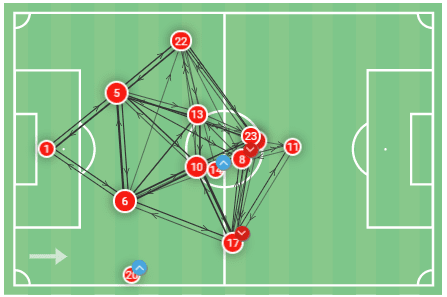
Quickly going back to the Arsenal example used earlier, Montemurro’s side doesn’t necessarily employ the aforementioned strategy regularly, but they have often resorted to this tactic to aid their possession dominance.
When Arsenal wants to keep a solid defensive structure on one side, they deploy Schnaderbeck as the left-sided full-back, giving Evans the freedom to attack on the right, just as they did against Reading.
The above pass map shows the full-backs positioning from the Reading game and the statistics to back their intentions.
The
Gunners’ expected goals (xG) were 2.39, with four counter-attacks originating down the right, with an xG of 0.67. Thus,66% of the counters were courtesy of Evans and Beth Mead.
However, one team that has executed this system is Manchester City Women.
Alan Mahon’s team has utilised this tactic with a good degree of success albeit through forced circumstances.
Aoife Mannion was former manager Nick Cushing’s right-back of choice until an ACL injury in the Champions League put her out for an extended spell.
Even though Matilde Fidalgo was available, Cushing chose to alter his tactics and deploy natural forward Janine Beckie at right back.
Cushing changed his formation to a 4-2-2-2 system that morphed into an asymmetrical shape with Beckie playing much higher on the right side similar to an auxiliary winger.
The right-sided attacker in Ellen White would position herself in and around the penalty area then move into the wide areas giving Beckie space to make marauding runs down the right flank.
The inside right midfielder – Jill Scott – also plays much narrower as she is closer to being an ‘8’ / ‘10’ hybrid than a wide player.
However, both players will try to interchange and create passing options for Beckie, creating space and dribbling opportunities for her to thrive.
Defensively, Caroline Weir and Kiera Walsh play as the double-pivot to give City protection in midfield.
Walsh and Scott were tasked with providing extra cover on the right-hand side, allowing Beckie to make attacking runs down the flank.
The left-back – Demi Stokes or Meghan Campbell – have played a more conservative role and position themselves in an area that is still wide enough to deal with the opposition winger but narrow enough to become part of a faux three-man defensive line along with one of Weir or Scott slightly ahead to create numerical superiority when the situation arises.
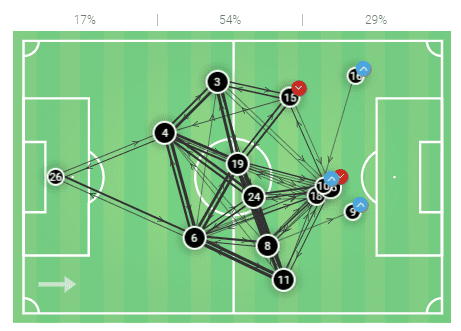
The pass map above illustrates Beckie’s attacking intentions through her advanced positioning.
It’s clear that the left-back sits much closer to the central defenders than Beckie, who is the primary outlet on the right side.
It is also vital to note the deeper double-pivot of Weir (#19) and Walsh (#24), which provides protection from central midfield.
Weir’s positional awareness allows her to roam midfield depending on the situation, as she is always at the right place at the right time.
They fill in the gaps to give City their numerical superiority at the back.
Depending on the full-back that has gone forward, Weir or Scott will slot into the wider position.
However, there are times when all four defenders have lined up in this position.
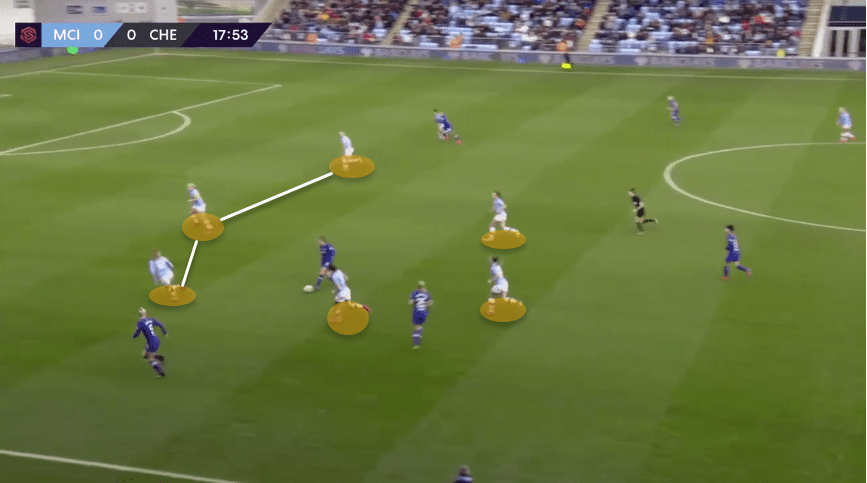
The defensive foundations set by City have been well implemented.
Here, we see Chelsea looking to counter-attack Manchester City.
However, the back four are already in position, and seven City players are back to overrun Chelsea’s counter-attack.
Guro Reiten’s pass to Bethany England limits the space for Chelsea to progress the ball forward.
England’s only choice is to send in a deep cross for the marked Sam Kerr on the far side.
Unless Stokes loses the aerial duel, this attacking situation should be easily diffused.
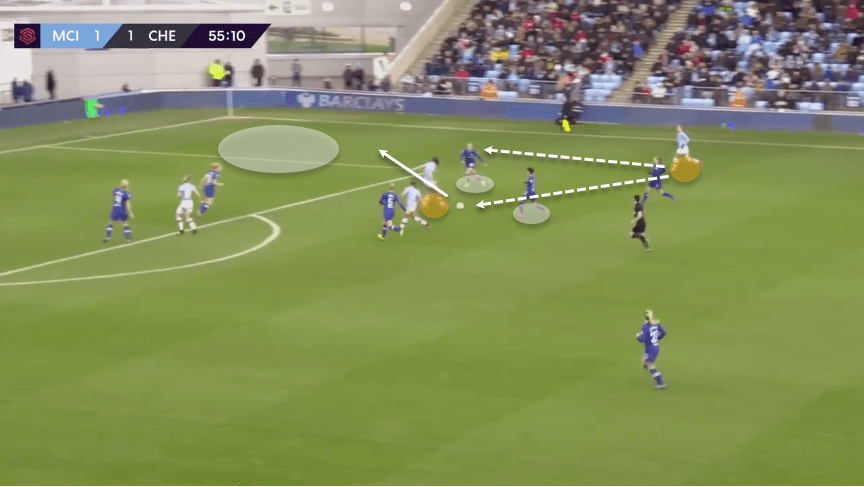
The role of City’s midfielders is vital to their build-up play.
Weir and Scott’s intelligent movement and understanding of space help the City attract pressure and open space in other areas.
Here we can see Beckie’s pass into Scott attracts two Chelsea Women players leaving Beckie with space and time to cross when the ball is returned.
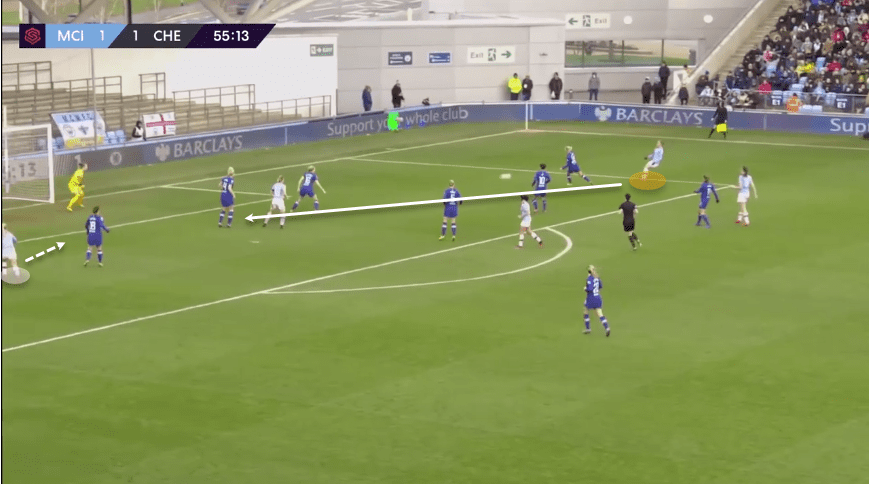
The core fundamental result of City’s attacking intention is seen in this image above.
It’s clear to see Lauren Hemp in an advantageous position over Maren Mjelde.
Hemp is able to make a blindsided run in behind to latch onto the cross.
While Beckie’s cross was cut out by Chelsea, this move personified the ideology behind City’s attacking movement.
The ‘inverted’ full-back system
Coaches have used full-backs in different ways, as we’ve seen in the above two case studies.
However, Olympique Lyon have used their full-backs in a slightly unorthodox manner in some of their matches across the last two seasons.
While we’ve discussed fullbacks in a range of formations, this is different because no other team usually employs this sort of system.
We will analyse and understand how Lyon have adapted their 4-2-3-1 to allow their full-backs to help create goal-scoring opportunities.
Essentially, Jean-Luc Vasseur has shown his tactical ingenuity by moving his full-back
, right-back Lucy Bronze, into a midfield position during build-up and transition.
The system aims to create space in the wide areas for the attacking wide forward to send in a cross or get closer to the penalty area to create a goal-scoring opportunity.
How is this achieved?
The answer, simply put, is Bronze’s movement from right back into a central midfield position while Alex Greenwood or Bacha provide width on the left side.
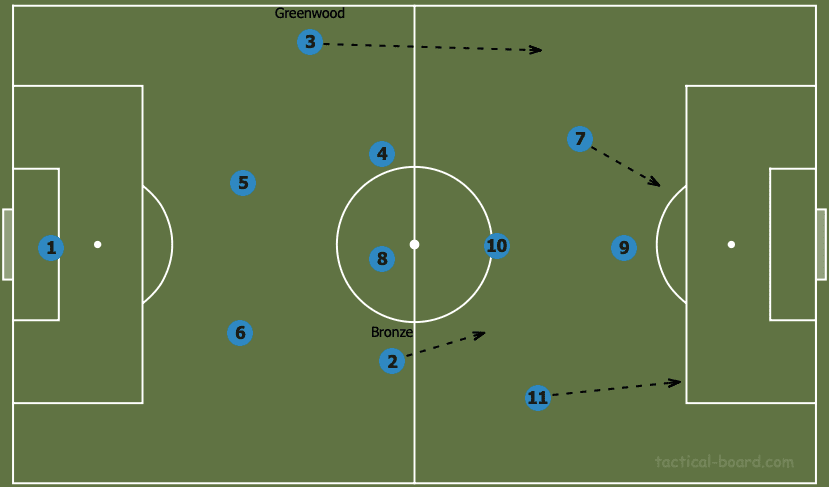
Bronze can be found in this position under two circumstances.
The first is when Lyon is trying to build out from the back and is faced by the opposition’s medium to low block.
The full-back looks to drive into midfield pulling the defending team into a narrower position to free up the right-winger and allow one of the defensive midfielders to move out wide.
The second circumstance is during opposition counter-attacks.
The full-back will attempt to add an extra body in midfield to support the double pivot and restrict any forward passes or movement, turning it into a Lyon counter-attack.
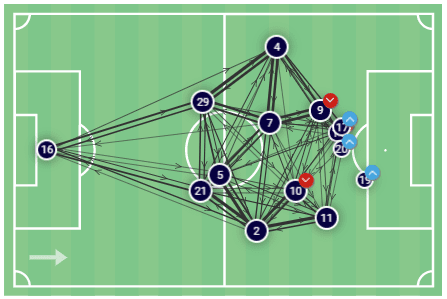
This pass map displays the average positions of Lyon’s players against Fortuna Hjørring in the Champions League.
What immediately stands out is Bronze’s (#2) positioning, which is slightly narrower closer to the central midfielder whilst Bacha (#4) remains in a wide left position to attack down the flank.
The left-winger is sitting in a much narrower position whilst Shanice van de Sanden (#11) is playing much further forward.
Being a natural winger she will tend to favour pushing out into the wide areas to cross or cut back inside.
Additionally, on both sides, Lyon have tried to create numerical superiority to overcome any opposition resistance and give themselves insurance against any potential counter-attacks through the middle.
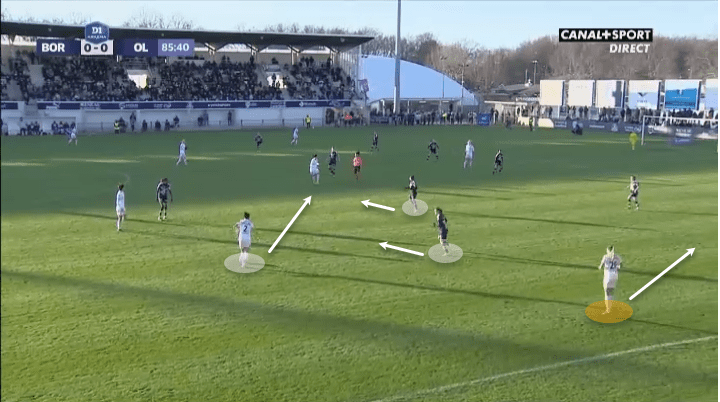
As we’ve discussed earlier in this section, Bronze’s move into midfield can help create space in the wider areas.
Here, Bronze is trying to break through a tough, compact team by making a narrow move into central midfield.
This has attracted the attention of the two highlighted midfielders giving Delphine Cascarino a free run down the right.
Bronze’s idea is to pass into Dzsenifer Marozsán and play a one-two pass combination to move the defending team out of position.
Not only has this given Cascarino space but also an option for Lyon to pass into creating space centrally.
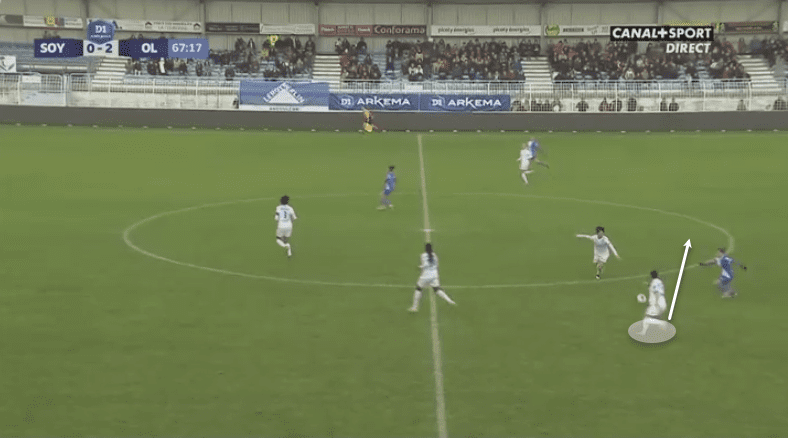
Bronze’s positional awareness and ability to track back to stop counter-attacks is impressive.
The Lioness’ right-back is seen here running back to try and stop the Soyaux attacker.
Being able to intercept and dispose of the player allows Bronze to initiate a counterattack, putting Lyon in a 6v3 situation.
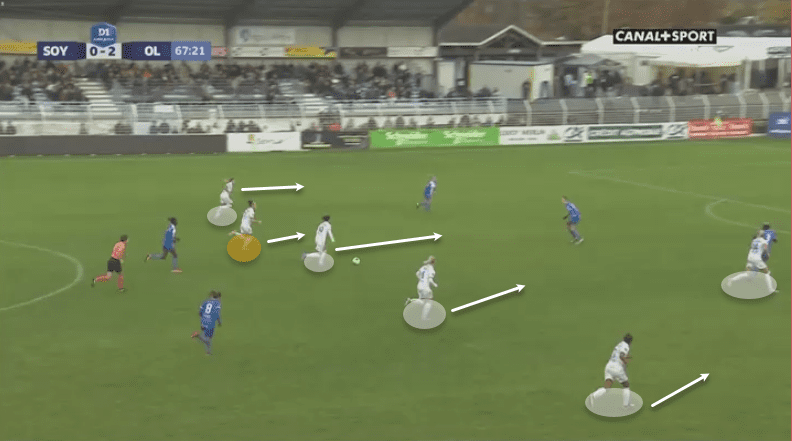
At left-back, Greenwood plays an equally important role by providing width, staying as wide as possible to create deep crossing opportunities for the dynamic Ada Hegerberg.
The Norwegian striker is an excellent complete-forward and thrives on both through passes and crosses.
Greenwood is much more effective in the final third than in the defensive third, and Lyon’s playing style suits her game.
The former Manchester United Women left-back’s movement allows Le Sommer to drift centrally closer to Hegerberg giving Greenwood space to create crossing opportunities.
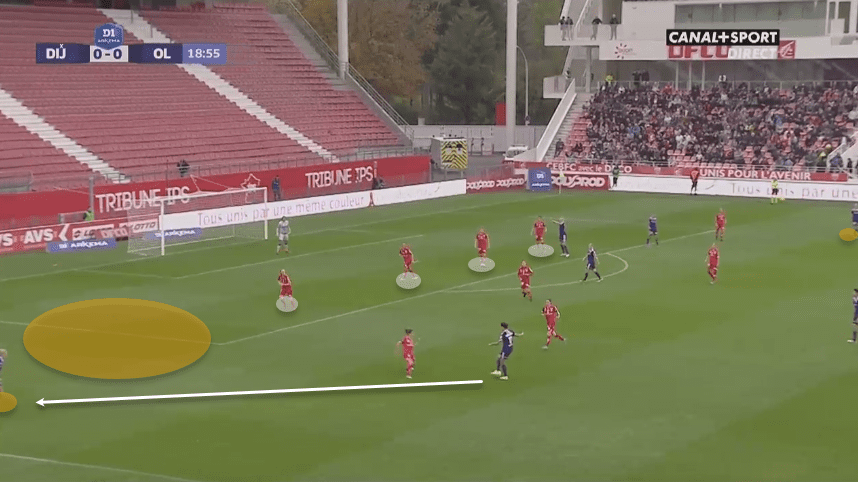
Here, it’s important to see the positioning of both full-backs.
Up against a compact Dijon side, Lyon was given the wide areas.
Both Bronze and Greenwood are in acres of space, but the right back is in a slightly narrower position, which naturally means Greenwood will stay wide.
Receiving possession from Marozsán gave Greenwood enough time to aim for the three Lyon attackers making an attempt to find space in the box.
Final Remarks
Given the number of systems we’ve discussed, it is clear how important fullbacks are and the tactical flexibility they provide.
Every situation we’ve seen here clearly shows how full-backs are used in different formations and how their attack or defense can help define a team’s playing style.
Each team has a distinct style and uses different types of full-backs to help stop opposition teams’ most dangerous players.
Even teams playing with the same formation can have different profiles of full-backs who can provide different types of output.
As we’ve seen with Arsenal and PSG, both teams can attack differently and affect their team’s movement at both ends of the pitch.
Women’s football will continue to grow, and the tactical complexity we see here can only improve as more and more teams continue to invest in the game.





Comments